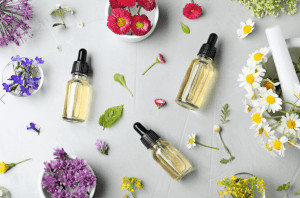Sage Oil For Hair: Benefits, Uses & More!

Sage has been used since before biblical times, and it’s one of the more ancient herbs in existence. It’s held great religious and spiritual significance for thousands of years, and has always and ever been seen by the Old World as a healer and bringer of wisdom, cleanliness, and higher consciousness. Seen as a purifying plant, it has been part of home decor and religious rituals since the dawn of civilization – and probably way before that.
Another thing which has been around since the dawn of civilization? Human hair. The hair on our head has also been held in great religious and physical significance. Nowadays, and since forever, many people are looking for ways to strengthen and fortify the hair on their head. Science and technology are making amazing discoveries, but we should not forget plant medicine, or the traditions of old.
Essential oils and other extracts are common remedies to revitalize and thicken the hair. Some people use these substances to prevent a situation from taking place, and others use them to treat an ongoing condition, chronic or acute. Genetics play a crucial role here, and keep in mind that male and female pattern baldness (aka androgenic alopecia) accounts for the vast majority of hair-related complaints in doctors’ clinics and treatment centers all over the world. But I digress. Before I get carried away, what exactly is sage?
What Is Sage?

Hand holding sage leaves.
The plant’s scientific genus is Salvia, which literally means “to save” or “to heal”, and its full name is S. officinalis. Homes, temples, dwellings, and abodes of all sorts are often purified through the use of this plant. Throughout history, sage has also been a culinary ingredient. You can even use it as a general cleaning agent and pesticide. Burning its dry leaves (smudging) or using it in incense is also highly popular.
The plant itself can grow to a height of about two feet, and can thrive for years. Native to the Mediterranean and parts of Asia, it is also a symbol of immortality. The idea of someone being a ‘sage’ or of giving ‘sage’ advice comes from this plant. Mostly thanks to its use and perception throughout the history of man.
While sage can be treated as a common household plant and nothing more, there is more to it than meets the eye or the nose. It grows fairly easily on dry land, gives off a refreshing mint-like scent, and is a pretty plant in the opinion of many individuals. You can grow it indoors or outdoors. The plant enjoys the sun but also takes pleasure in the shade. An easygoing herb, by all accounts.
What Is Sage Good For? Top Sage Health Benefits
The leaves of the sage plant have also been used as medicine for a very long time, aiding in a variety of medical conditions or promoting better health in general. It can help to ease the emotional and physical symptoms of PMS and menopause.
Some chew sage leaves like mint leaves, and seeing as how this plant is part of the mint family, it is a common use for it. The antimicrobial properties of the leaves (or oil) can help reduce the amount of harm-inducing bacteria in our mouth and specifically the teeth. This herb has been singled out as a great way to enjoy a cleaner mouth and increased dental health.
You can also help blood sugar levels and bad cholesterol levels with the sage plant. Additionally, you can use sage as a natural way to counteract sugar-related illnesses like diabetes. Regular consumption of sage leaves can help your body’s reaction and interaction with insulin.
Digestion is another facet of health that you can improve with the help of sage. You can reduce symptoms such as loss of appetite, gas, stomach pains, diarrhea, bloating, and heartburn. At times you can even eliminate them altogether, using the leaves of the salvia plant.
Sage may also improve cognitive function, especially in the case of memory. Because of this, sage is being looked into as a preventive and reactive treatment for Alzheimer’s disease. It’s a long way from becoming a bonafide medicine on the shelf, but studies have shown promising results.
These are perhaps the top benefits of sage for the body, though hair is also a major part of the human form that can find strength and vitality through the usage of sage. Actually, sage essential oil is how you primarily achieve the benefits for hair.
How Is Sage Essential Oil Made?

Vials of essential oils.
You produce sage essential oil primarily through the process of steam distillation. The procedure extracts the different chemicals and beneficial compounds from the organic matter. It separates them and keeps the essence of the plant. Unlike carrier oils or plant extracts, the process of steam-distilling herbs into an essential oil is lengthier. It also involves much more of the physical plant matter.
The leaves and twigs of the sage plant are grown, harvested, and then gathered into bunches. The bunches of plant matter go in boiling water, which nowadays are large (often industrial) vats. You leave the leaves in the boiling water for some time, usually 4-6 hours. The heat is partly what breaks down the plant at a cellular level, and it helps the extraction process take place. But it is not heat distillation, it is steam distillation.
The steam which is produced by the boiling water is used to draw out the phytochemicals and bioactive compounds. The process of natural evaporation leaves you with the raw, essential, organic stuff. Steam distillation (that is to say, separation of matter through evaporation) is a process that has been used since the time of Ancient Greece, and it still keeps going today.
As ancient, beneficial, and widely-known as this process is, it’s important to note that distillation via steam is not always the best method of extraction in all plants. There are other methods still in use today.
The steam within the boiling vat causes separation, and it is then moved to a separate chamber for cooling. Here, the steam’s temperature drops and condenses, naturally forming droplets that slowly gather at the center of the chamber. As the droplets gather and group together, they form the raw and potent liquid which we all know as an essential oil.
The reason why steam distillation is still one of the most popular methods of manufacturing essential oils is because it often produces a high-quality product without any further intervention, no chemical additives, and little to no impurities getting through. While other methods do exist (and some are preferable in the case of other oils) when it comes to sage essential oil it is generally true that steam distillation produces the purest and most beneficial results.
Because sage can be – and is – used on skin, hair, scalp, and even taken internally as food or medicine, it is usually best to go for the steam-distilled option. This basically guarantees that the oil did not come into contact with any unwanted chemicals or other ingredients that may compromise its integrity. Many vials of store-bought essential oils will state whether or not the product has been steam distilled. In case it doesn’t you should inquire as to its origin to avoid any issues.
Sage Oil For Hair Explained

Woman using oil on her hair.
Sage oil has proven to be very useful for the hair and scalp. This is thanks to the oil’s naturally high levels of antioxidants, vitamins, and minerals. It is rich in vitamins A, B, C, calcium, and potassium. Maintaining a healthy head of hair encompasses a lot of factors. These ingredients are quite essential for the proper development of the hair strands.
You can often find these nutrients in different shampoos or hair care treatments. The oil of the sage plant can help rid the scalp of buildup, bacteria, and free radicals. These can all prove to be a hindrance to the process and rather damaging, by and large. Some amounts of grime or bacteria can be good, but keep it in check in order to avoid issues.
Sage essential oil penetrates the surface of the scalp and delivers these all-important nutrients directly to your hair follicles. Several hairs may sprout from a single follicle, so providing them with these beneficial building blocks may help them become better, stronger, thicker, and more developed hairs overall.
Sage may or may not have the desired effect, depending on the stage in which your hairs are. At any given moment, all of the hairs on your head are in one of three stages (growth, transition, rest). Each hair strand and follicle has its own timeline. By correctly utilizing sage oil, you may be able to get the best of what it has to offer, without exposing your scalp and hair to any kind of potentially-harmful chemicals and/or other influences.
It’s a great way to help your hair retain moisture while getting rid of excess oil and maintaining optimal pH levels. In most cases, it won’t dry out your hair but rather leaves it feeling and looking good.
Top Clary Sage Oil Uses For Hair

Woman admiring her hair in the mirror.
The plants sage and clary sage are sometimes used interchangeably because of their name. In fact, they are quite different in many ways. Although they’re made of different ingredients, they do share several benefits. You can use clary sage oil topically on the scalp to strengthen hair strands and follicles, prevent hair loss or thinning, and stimulate healthy hair growth overall.
By strengthening the existing hairs and follicles, you could manage to sustain the follicles and strands which are in their resting phase. This can contribute to the thickness of the shaft and the overall volume of the hair on the head. The chemical makeup of clary sage oil can help to reduce the effects of hair loss in men and women of all ages. You can add it to your shampoo or hair care products. Be sure to do so wisely as it is a highly potent substance.
Massaging clary sage oil directly onto the scalp is another way to get it into your system. A scalp massage – especially with an essential oil – will get the blood to flow to the area. It also provides the hairs with more opportunities to take those good life-giving nutrients. Stronger, thicker, properly developed hair often translates into less thinning, less shedding, and better-looking tresses.
How To Use Clary Sage Oil: DIY Clary Sage Oil Hair Mask Recipe & Guide

Essential oils for DIY.
Well, first off, you can use clary sage for much more than its hair-related benefits. When in oil form (usually distilled by using steam), it may have a profound effect on vision, cleanliness, clarity of mind, and hormones. Many people use it specifically for hair-related conditions or as a hair tonic. Some also add the oil to other natural ingredients to make a DIY hair mask.
Clary sage blends really well with other popular oils. Specific oils include lavender, peppermint and spearmint, patchouli, and cedarwood (to name a few). Using it as an addition to your mainstream conditioner is another way to get good use from this potent plant extract.
Here is a strengthening DIY hair mask recipe, which includes clary sage, You can tailor it to suit your own wants, needs, and preferences.
Ingredients
- Tbspn castor carrier oil
- Tbspn jojoba carrier oil
- Tspn hemp carrier oil
- 5 drops of each oil: clary sage essential oil, lavender essential oil, and patchouli essential oil
Combine ingredients, and (ideally) place within a dark glass vial. You can use any other essential oils you want, really. It’s all about what kind of effect it has on your scalp and hair. Experiment and see what works best for you.
Use this mask on clean and dry hair for best results. Apply some to the scalp and massage the mask into your hair. Use a circular motion to spread the mixture evenly and get the blood flowing to the area. Apply to the hair strands themselves, but don’t use too much force. You can also comb it in and make sure it spreads evenly.
Leave the mask in for 15 to 20 minutes, then rinse it out and shampoo as usual. You may also decide to use it as a leave-in, and rinse and wash the following morning. You can use a hair mask once a week or so. Your situation may be different depending on your hair type, and your scalp/hair’s ability to retain moisture and grow. If your hair is exceedingly dry and/or damaged, try twice a week for some time (but not as an ongoing routine).
Store the clary sage oil hair mask in a cool and dry place. Avoid overexposure to sunlight, oxygen, and extreme temperatures. Rancid oil is not one of the things that you’d want on your scalp, your hair, or your body in general. If it looks off, smells off, or is causing any kind of issue (rash/discomfort of some kind), don’t take a chance on it. Just make a new batch.
Conclusion
The plants we call sage and clary sage have their benefits and their respective characteristics. When it comes to hair, there are so many contributing factors other than the products you use. Anything from stress and poor eating habits to excessive styling and over-washing could be the reason for hair damage to express itself. There is no guarantee that essential oils will be any kind of cure or remedy.
That being said, incorporating essential oils into your beauty routine (and specifically your hair care routine) can prove to be a great move for your locks and scalp. You can use both essential oils and carrier oils alike as herbal remedies for the body and mind; a kind of tonic to help keep things running smoothly and efficiently. This has been going on for thousands of years, and in many ways, it is the bedrock of modern-day medical science.
Sure, some ancient medical practices of the Old World have been dispensed with – and rightly so! But now, maybe more than ever before, science is finding more and more benefits and positive attributes which exist within these natural substances known as essential oils. They are some of Mother Nature’s most potent herbal remedies.
Some say that New-Ageism and pseudo-science have given essential oils a bad name, and maybe that’s true to some extent. Generally speaking, clinical studies of essential oils are showing inconclusive results. This is largely because plant medicine is not as predictable or replicable as pharmaceutical medicine. The results will often depend on a spectrum of variables, which is why the FDA does not hold essential oils to any specific regulations, and why it has not granted these substances any kind of special status.
Plants were here long before the first scientist or inventor walked the earth. They provide us with sustenance, medicine, shade, beauty, and more. Consult with your health care provider, and see if you can incorporate these miracle oils into your life (and hair). Using sage and clary sage for hair may be the very thing that helps bring your strands back to life. Don’t hesitate to give it a shot.


